See Guangzhou again--Runaway Yuexiu Park
Walking time: 2020.7
D1:
Walking method: Self-driving by plane (Nanjing-Guangzhou)
Walking route: Nanhai Temple (Tour time: 1.5 hours, ticket: 15 yuan) Lingnan Impression (Arrived at 16:40, closed at 5 o'clock, unable to enter) Guangzhou University Town Science and Technology Museum (appearance) Foraging on Beijing Road
Check-in: CityNote Sinoo Hotel (Guangzhou Beijing Road Dafosi Park Front Subway Station Branch)271 yuan/standard room
D2:
Walking method: walking, renting
Walking routes: Lu Xun Memorial Hall (1.5 hours, online reservation in advance, tickets are not available), Guangdong Museum (1.5 hours, online reservation in advance, tickets are not available), United Bookstore
Check-in: Beijing Road Sino Hotel
D3:
Walking methods: walking, subway
Walking routes: Nanyue Palace Museum (1.5 hours, no tickets), Yuexiu Park (2 hours, online reservation in advance, no tickets), Guangzhou Museum, Yuehai Tower Foraging
Check-in: Jinzhou Hotel (Guangzhou Yuexiu Park Subway Station Branch) 207 yuan/standard room
D4:
Walking method: walking, renting
Walking routes: Sun Yat-sen Memorial Hall (free tickets for medical staff), Beijing Road, Tao Tao Ju foraging
Check-in: Guangzhou Huamao Guangfu Cultural Hotel 151 yuan/standard room
D5:
Walking methods: bus, taxi, subway, plane (Guangzhou-Nanjing)
Walking route: Shangxia Ninth Street, Xiguan Dawu, Liwan Lake Park, Xintai Le Dining
D3:
Walking through Beijing Road from the Nanyue Palace Museum back to the hotel, checking out, and traveling to Jinzhou Hotel in Yuexiu District. The hotel is located right at the subway entrance of Yuexiu Park, which is very convenient. The hotel is located on the west side of Jiefang North Road. Through the glass windows, you can see the undulating hills and green wooded Yuexiu Mountain opposite. To see the amusement facilities in Yuexiu Mountain realistically, it must be very close to the entrance of the park. I have been to Guangzhou many times, but this is the first time I have set foot in Yuexiu District. Yuexiu in Guangzhou is also a representative of the old city. I feel that I have traveled around Guangzhou many times over the years. This is the first time I have set foot here. The journey is sometimes so interesting. Take a short rest and set off. I asked the staff at the entrance of the hotel and learned that the main entrance of Yuexiu Park, which is the door opposite the hotel, is not open due to the epidemic. Now you have to enter the park from the west gate. So we set out on foot. Next door to the hotel is the Western Han Dynasty Nanyue King Museum. I did not visit inside and continued to set out for Yuexiu Park as originally planned.

A few hundred meters across Jiefang North Road is the west gate of the park. The old Yuexiu Park, built in the 1950s, is a free citizen park. By reservation, you can make an appointment on site. For the schematic diagram at the door, first understand where you are, choose the direction, plan the points you want to see, and confirm the route.

I first ran to the Wuyang statue. When I was very young, I knew that the statue of Wuyang was the city emblem of Guangzhou. It's a pity that I haven't really seen this statue many times I have traveled back and forth to Guangzhou. So I was actually a little excited today. It was like meeting a big shot he had admired for a long time.

After climbing dozens of steps, I finally saw her real face on the top of the hill.

The sculpture was built in 1959. The entire building is carved from 130 pieces of granite. The base is more than ten meters high and needs to look up. I walked around them several times with joy and a little relief.
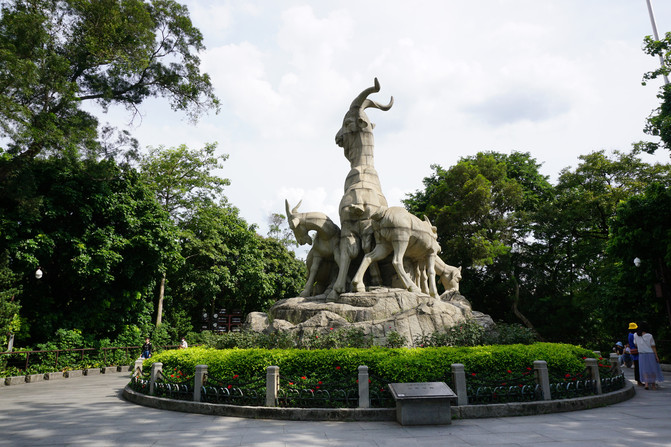
On the top of the mountain, there are archways, pavilions, platforms, corridors, steles and other buildings around the sculpture.

After seeing the Wuyang sculpture, one wish in my heart was fulfilled, and I chose my way to continue walking through the mountains. Although we are walking in the mountains, the slope is very gentle and walking is easy. In addition, the vegetation is rich and the scorching heat is blocked. The high concentration of oxygen released by the green trees and vegetation makes my steps relaxed and happy.


Continue east and follow the signs into the hills.

Between the hills, there is a lake water deep in the shade. There are three artificial lakes in Yuexiu Mountain, named after their directions-Dongxiu Lake, Nanxiu Lake and Beixiu Lake. The lake I see now is called Nanxiu Lake. Deep deep in it, it is peaceful and meaningful.

I chose to go south after circling Nanxiu Lake. I didn't expect there to be a section of city wall here. From Nanjing, I am no stranger to the city wall at all. I also have an inexplicable impression of it. I feel that a city with a city wall has connotation.

After reading the introduction, I realized that this is the Ming City Wall. This is a historical relic of Guangzhou City Wall. After the Revolution of 1911, Guangzhou demolished the city wall and built roads. This is the only section left of the city wall of Guangzhou, which has a history of more than 2,000 years.

The ancient city wall is lush with lush grass

Looking up, the jagged city wall winding on the towering city wall.

This lush root system radially covers the wall, giving a desolate and solemn taste


You can climb the city wall by climbing up stone steps on one side

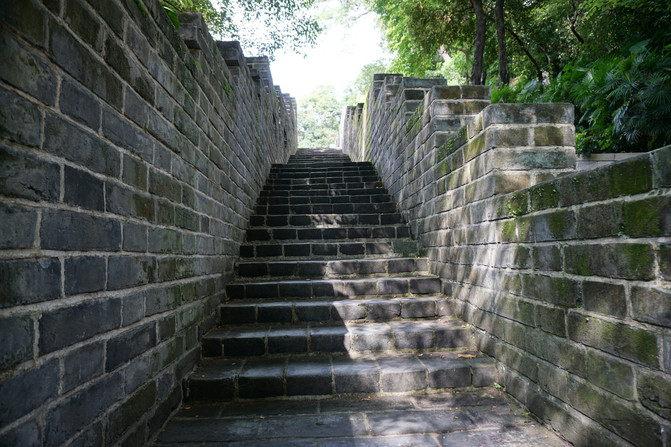
The city wall is built with large blue-gray bricks

overlooking

There is also a Yuexiu Mountain water tower next to the city wall, but because the vegetation is too dense, it cannot be clearly seen from the road, and there is no way to get close to it because of the overgrown vegetation. So I took this introduction to let everyone understand it.

Continue south along the wall

Where the city wall is located is also the historical site of the Guangzhou Uprising-the Guanyin Mountain Battle Site.

There are seven hills in Yuexiu Mountain, so you will climb mountains from time to time during the mountain. Here, there are hundreds of steps leading up to the main peak of Yuexiu Mountain, Yuejing Gang at the southernmost tip. The Sun Yat-sen Monument stands on the hill.

There are two archways walking halfway up the mountain. One is the "Foshan" stone archway built during the Daoguang period of the Qing Dynasty. The archway faces north to south, with four pillars and three rooms on the first floor. It is built of granite and has a simple style. The large characters "Foshan" are written on the top of the archway.
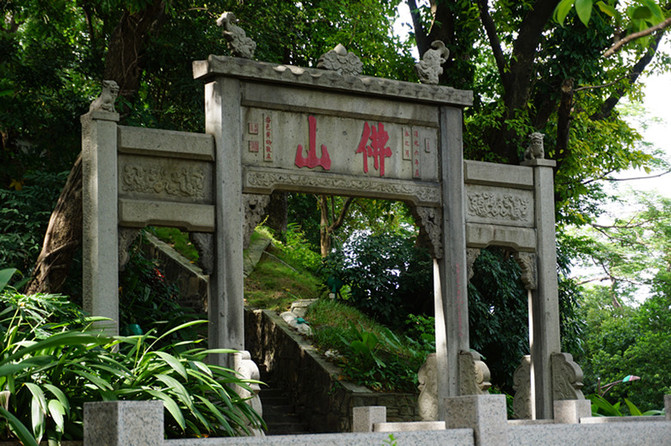
Above the "Foshan" archway is the "Ancient Chu Court" archway built in the Qing Dynasty. The archway faces east and west. It is a stone archway with two pillars, a single room and the first floor. It is also built of granite, with four drum holding stones standing at the foot of the pillars.

Continue to climb to a platform among the lush trees on the top of the mountain, on which stands the Sun Yat-sen Monument. The body of the stele is all made of granite and is 37 meters high. The bottom of the stele is square, tapering and pointed upward. The Sun Yat-sen Monument is an important commemorative building in Yuexiu Park to commemorate and commemorate Mr. Sun Yat-sen's revolutionary spirit.
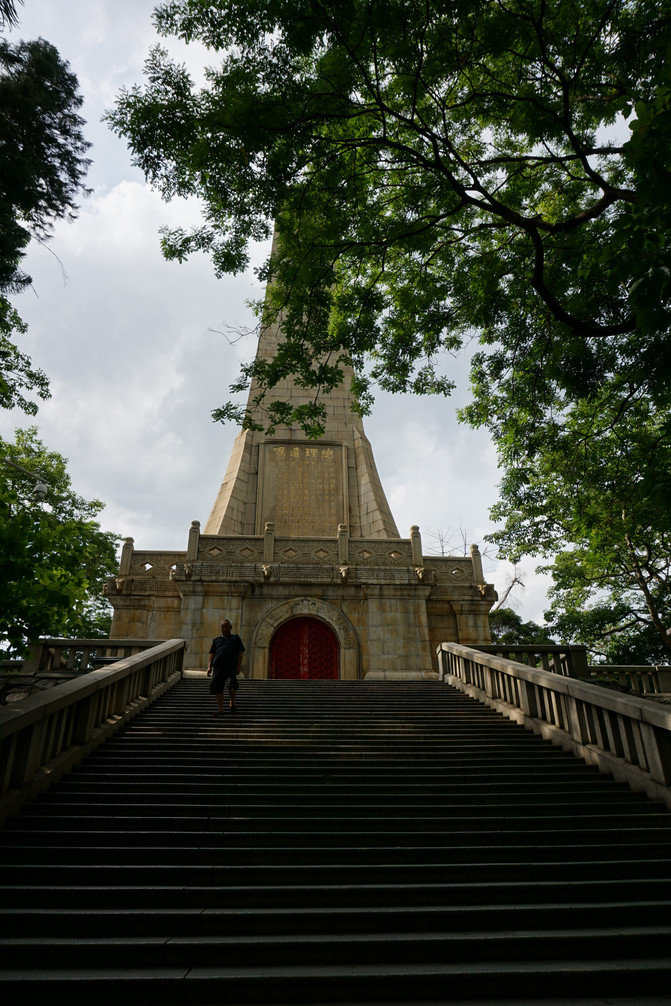
The front of the stone tablet is a giant granite about 7 meters long and 4 meters wide. Sun Yat-sen's will written in golden official script is engraved on it. The inscription shines in the sun.

On the side of the stone tablet, there are exquisite stone carvings on the guardrail of the stone tablet. There are a total of 26 sheep stone carvings in the four fence patterns on the upper layer of the stone tablet base, symbolizing Yangcheng.

The monument was built in 1929 and designed by the famous architect Lu Yanzhi.
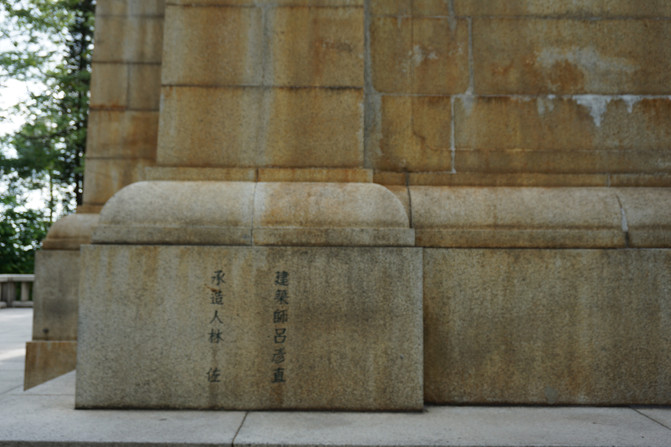
From the monument down the hill, on one side is Yuexiu Stadium, a stadium built between the hills.

I thought this stadium was built in line with the requirements of modern times. It was only when I wrote this travel note that I realized that Yuexiu Mountain Stadium was an old stadium built in 1950 when I used some common sense. It is the People's Stadium that Marshal Ye Jianying, the first mayor of Guangzhou City, called on young people to build with their own hands. Therefore, the development of a city and its philosophy are closely related. The stadium has 30,000 spectators and has a glorious history. It has hosted influential domestic events such as men's and women's football matches in the 6th and 9th National Games. There is also a youth amateur sports school here, which has cultivated many outstanding athletes.

The enclosed building behind the door of this crimson Guangzhou Museum is Zhenhai Tower. It is an eye-catching pearl of Guangzhou's cultural and historical sites and is known as the first scenic spot in Lingnan. I will introduce it separately in my special introduction to the Guangzhou Museum.

I visited the museum in the last 15 minutes before the museum was closing, and left the museum and continued east. There are two pavilions on Xiaopanlonggang.

This four-corner stone pillar pavilion is the Guangfu Pavilion.

The Guangfu Pavilion was built by the people of Guangzhou and Hong Kong after the victory of the Anti-Japanese War to commemorate the victory of the Revolution of 1911 and the achievements of Hong Kong compatriots who generously donated huge sums of money to support the Revolution of 1911.
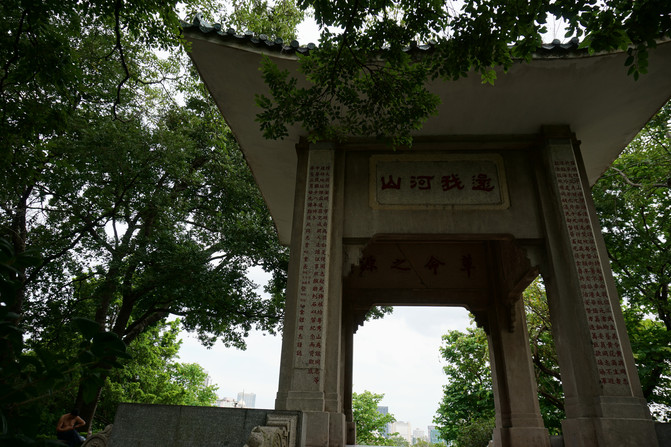
The inscriptions on stone carvings inside and outside the pavilion introduce this history.

The four corners are spires, the green glazed tile roof, the plane is square, there are steps on all sides, and there are drum stones on the sides of the steps.

A few steps away from the Restoration Memorial Pavilion is the Seamen's Pavilion. This double-eaves octagonal peeple pavilion was built to commemorate the victory of the Hong Kong Seamen's Strike in 1922.

The archway of the seafarer's pavilion

I have seen basically all the historical relics in the area away from the Seamen's Pavilion. Most of the north side of the mountain are amusement parks, so I didn't go north, but continued south, thinking of getting out of the park from the south gate.

Another section of the city wall.

How happy it is for nearby citizens to run and walk slowly in such a place with natural scenery and historical monuments.
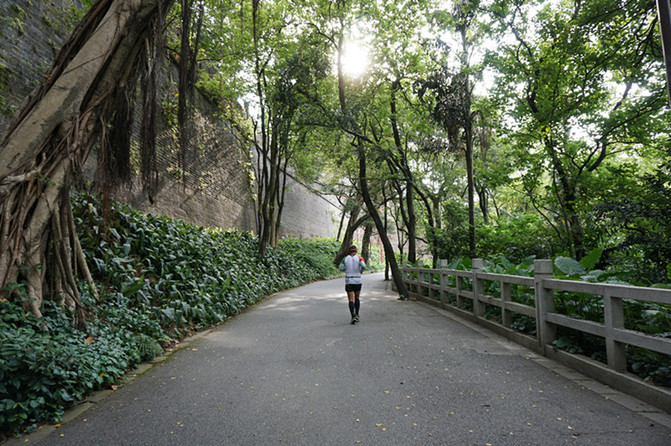
Up the mountain and down the mountain, there is a monument to Sun Yat-sen's Reading and Administration Office halfway up the mountain. It has a pointed square column shape. This was originally the former site of Yuexiu Tower, and it was also the place where Sun Yat-sen and Soong Ching Ling lived.

Go to the foot of the mountain and look back

You can see the building complex of Sun Yat-sen Memorial Hall across the street.

Yuexiu Park South Gate

The Sun Yat-sen Memorial Hall is separated by Yingyuan Road. The museum is closed at this time. If you live nearby and find leisure, you will come here for a stroll.

I finally fulfilled a wish. After seeing this representative park in Guangzhou City, I feel a kind of happiness called satisfaction.
Previous Article:Huangpu Ancient Port and Ancient Village-the Starting Point of the Maritime Silk Road
Next Article:Guangzhou 24 hours, food, accommodation and play strategies
